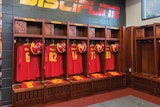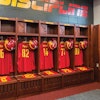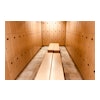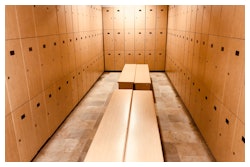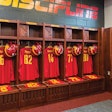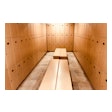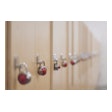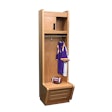In Europe, saunas and steam rooms are commonplace. In Finland especially, where the traditional sauna has its roots, saunas are simply a part of life.
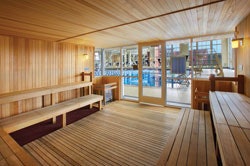 Ample glass and a high-visibility location on the pool deck help discourage inappropriate uses of saunas and steam rooms. (Photo by Sam Fentress/Fentress Photography, courtesy of Hastings + Chivetta Architects Inc.)
Ample glass and a high-visibility location on the pool deck help discourage inappropriate uses of saunas and steam rooms. (Photo by Sam Fentress/Fentress Photography, courtesy of Hastings + Chivetta Architects Inc.)Most Finns grow up with a sauna in their home, and using it becomes a weekly (if not more frequent) ritual from childhood on.
Though not as ingrained into the American culture, saunas and steam rooms are a major draw in the United States for people looking to soothe muscles after a workout, lose weight, heal the body, remove toxins or simply relax after a long day. As the cost and time needed to maintain saunas and steam rooms decreases and energy efficiency increases, more health club owners are looking to add these amenities to their facilities.
Despite the benefits, the addition of a sauna or steam room should not be undertaken without a fair amount of consideration. Unlike in Finland, where users know how to work a sauna as though it were any other household appliance, the typical U.S. club member is often unfamiliar with how to use a sauna properly - and the typical club owner may not know how to best take care of either a sauna or steam room. For the uninitiated, the nature of the steam room and sauna - a harsh environment set off from supervision - lends itself to risks.
As with any product, there are discrepancies between the way these amenities are intended to be used and how they are actually used. As Tom Frisbie, manager of Teton Sports Club in Jackson Hole, Wyo., says, "Whatever people can do, they will do. You have to expect anything."

250+ Exhibitors & 190 Educational Sessions | abshow.com.
Vandalism is one of the more common types of misuse, especially in recreational clubs and resorts, where the user demographic includes not only people interested in these spaces' health benefits but those attracted by the social draw or entertainment value. Club owners have experienced users defiling signs, tampering with seating or other infrastructure and leaving behind garbage or other messes. The Teton Sports Club has a membership of about 750, but Frisbie believes that most of the problems are caused by vacationers passing through.
To curb vandalism or misuse perpetrated by teens, Frisbie, like many other facility owners, has created rules restricting sauna and steam room usage based on age. For example, YMCA regulations vary by facility, with some prohibiting users under the age of 18 and others allowing visitors as young as 13. Still others require adult supervision.
One of the worst and potentially most dangerous problems involves users interfering with a sauna's heating element. There is no shortage of club owners or managers who can share their experience of a user urinating on the heating element or pouring something other than water onto it. At best, the substances do no harm, but they necessitate a thorough cleaning of the heating element. Sometimes the heating element will sustain damage and require replacement. In the worst-case scenario, substances such as oils can start a fire and endanger users.
The rocks in a sauna are meant to have some water added, so giving users access to the proper tools to do so reduces the likelihood of users seeking out their own methods of increasing the room's humidity. This can still lead to problems, though, when users disregard guidelines, so many club owners prefer to discourage water usage altogether.
"We supply bucket and dipper," says Reino Tarkiainen, president of Portland, Ore.-based Finlandia Sauna, "but the club owners usually don't put them in. It's okay to use clean water if you know how to do it."

The design of sauna heating elements has remained the same since 1962, according to Jon Vanderpool, commercial sales manager at Am-Finn Sauna and Steam in Eagle, Idaho, though added safety features have reduced many of the risks associated with them. Am-Finn offers a special heating-element model that separates the heating element from the rocks using a stainless steel tray. Thus, water (or other substances) added to the rocks does not come into contact with the heating element, lowering the risk of harm. Sauna and steam manufacturers have also added other features to combat users' attempts to tamper with the controls.
"No matter how hot you run the room," says Vanderpool, "You're always going to have someone who wants it hotter. If they have a way to manipulate the sauna heater, they'll do it; they'll figure it out."
Users of steam rooms often try to increase the steam output by manipulating the temperature gauge or steam element. Increased steam can make the environment uncomfortable as well as dangerous, raising temperatures to unsafe levels or causing skin to feel like it is burning. To circumvent this problem, rooms can be designed with the temperature sensor inside the shell of the heater, where users can't access it.
"Another thing facility operators like to do is go with a 24-hour timer," says Vanderpool. "They can preprogram the hours of operation for the room so that it turns on automatically in the morning and turns off at night. Members don't have access; it's all run off controls in a self-contained unit."
In the event that a user is able to manipulate the controls or some other problem occurs, sauna heaters come with high-limit switches, which shut down the heating element when a preset temperature is reached or surpassed. Also available are alarms that clubs can install in the rooms - either audible alarms or mechanisms that disconnect the power to the heating element.
Such safety features reduce a lot of the risk associated with users tampering with the environment, but not with some of the inappropriate behaviors endemic to saunas and steam rooms. For example, users who want to take advantage of the benefits of steam to their skin sometimes do their shaving in the steam room. Shaving cream and razors can leave behind messes or lead to damage, and the hair and potential for cuts and blood create hygiene issues.
More problematic than shaving is the possibility of sexual activity (consensual or otherwise). The behind-closed-doors nature of these building spaces creates a temptation and opportunity for steamy (or dry-heat) encounters. This is one of the reasons that more facility operators and architects are moving steam rooms or saunas out of locker rooms and onto pool decks or into other more visible areas.
"The more private or gender-specific rooms are usually at the private clubs or hospital-based wellness centers," says Robert McDonald, senior principal at Denver-based Ohlson Lavoie Collaborative. "Public recreation centers and YMCAs are increasingly leaning toward the other model. We try to address all of the issues upfront in the pre-design phase, talk about the type of clientele they want to attract and what kind of amenities they want to see in the locker room versus out on the pool deck."
The most obvious advantage of having one larger unisex sauna or steam room instead of two smaller spaces is the reduction in maintenance costs. The major complaint among owners of steam rooms has always been the upkeep - the environment of a steam room makes it a prime breeding ground for mold and bacteria, necessitating thorough daily cleanings.
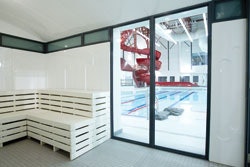 Fiberglass construction is associated with lower maintenance, but still requires daily attention. (Photo courtesy of Am-Finn Sauna and Steam)
Fiberglass construction is associated with lower maintenance, but still requires daily attention. (Photo courtesy of Am-Finn Sauna and Steam)The advent of fiberglass steam rooms has done away with many of these complaints. "Fiberglass steam rooms have been on the market for about 10 years," says Vanderpool, "They are becoming very popular now because they have lower maintenance requirements. Typically, they're 30 to 50 percent more efficient than tile, and the units we have are self-cleaning, using ozone."
Even with lower-maintenance models, saunas and steam rooms still require some daily cleaning and staff to ensure that everything is in proper condition. Not only does having one unisex steam room or sauna instead of separate amenities cut maintenance costs and reduce the amount of staff time required to supervise the areas, having the facilities on the pool deck gets them out in the open. In addition to watching over the pool, lifeguards are now finding care of the steam room or sauna added to their rotation schedule.
Despite the reduced element of privacy, some may argue that the potential for sexual behavior increases with a shared room. In reality, shared usage of a sauna or steam room usually means more traffic, facility operators say, leaving fewer opportunities for total privacy.
"We supply a glass door so you always have visibility. Management doesn't have to go through the door but can look in," says Finlandia's Tarkiainen. Simply having windows decreases the privacy factor and thus potential for vandalism or inappropriate behavior. Fiberglass steam rooms provide a similar benefit, as they can be built with a front wall made completely of glass, Vanderpool says.
These steps are not always enough to prevent uneducated users from behaving in ways they don't realize is harmful or inappropriate. "There are health risks to people staying in them too long, and you might actually see people exercising in them, as well," says McDonald. Prolonged exposure can lead to dehydration or heat exhaustion, especially after a hard workout (or combined with consumption of alcohol - a problem often seen in resort facilities). People with heart or respiratory conditions should take heed before entering a sauna or steam room, and despite studies indicating that the heat of these facilities can increase resistance to illness, it can be detrimental to those who are already ill or running a fever.
"Each sauna has a warning not to stay in for more than 30 minutes. We supply that with every heater," says Tarkiainen. Signage is the easiest way to educate readers on the dos and don'ts. Comprehensive rules should include not just how to use the room properly, but identify health risks and dictate proper dress, hygiene, behavior, and time and age restrictions.
But signs are easily ignored or overlooked, and should not be relied upon to enforce sauna or steam room rules. For membership facilities, education of proper practices and health risks should be addressed before initial use, and clauses addressing misuse included in the membership agreement.
In clubs like Frisbie's, however, where a large number of users are visitors, it's harder to ensure everyone is provided with that information. "We do give everybody a little speech every time they come in," he says. "But even still, we have to keep our eyes on them."
The best way to minimize the risks associated with saunas and steam rooms is not to rely on users to know and follow the rules of operation: Staff walk-throughs are the most common and effective means of preventing inappropriate behavior or misuse.
"Most clubs should have somebody who will check into the sauna at least every 15 to 30 minutes," says Tarkiainen. Scheduling walk-throughs at regular intervals during the day allows staff members to ensure that users are following posted rules, not exceeding time limits or suffering from any health issues. This also gives staff a chance to make sure all equipment is working properly and to catch and remedy any vandalism or other potential problems. Walk-throughs should be accompanied by a checklist documenting conditions.
When a club's staffing schedule makes it impractical to do regular walk-throughs, surveillance and monitoring equipment is recommended. A combination of visual and electronic surveillance is better still. Cameras placed outside of the rooms can be used to actively monitor usage or create a record that can be reviewed later.
Saunas and steam rooms don't have to be a headache for owners and managers. With proper planning, maintenance and staffing, as well as education on the part of the management team and users alike, the risks associated with these rooms can be minimized. Facility owners should not hesitate to take on the challenge associated with saunas and steam rooms in exchange for the many benefits they can bring to their business.
"There are a lot of people who will buy a membership simply because of the amenities a facility has," says Vanderpool. "If the rooms are down, we hear from those people; they're always the ones who complain the loudest."










